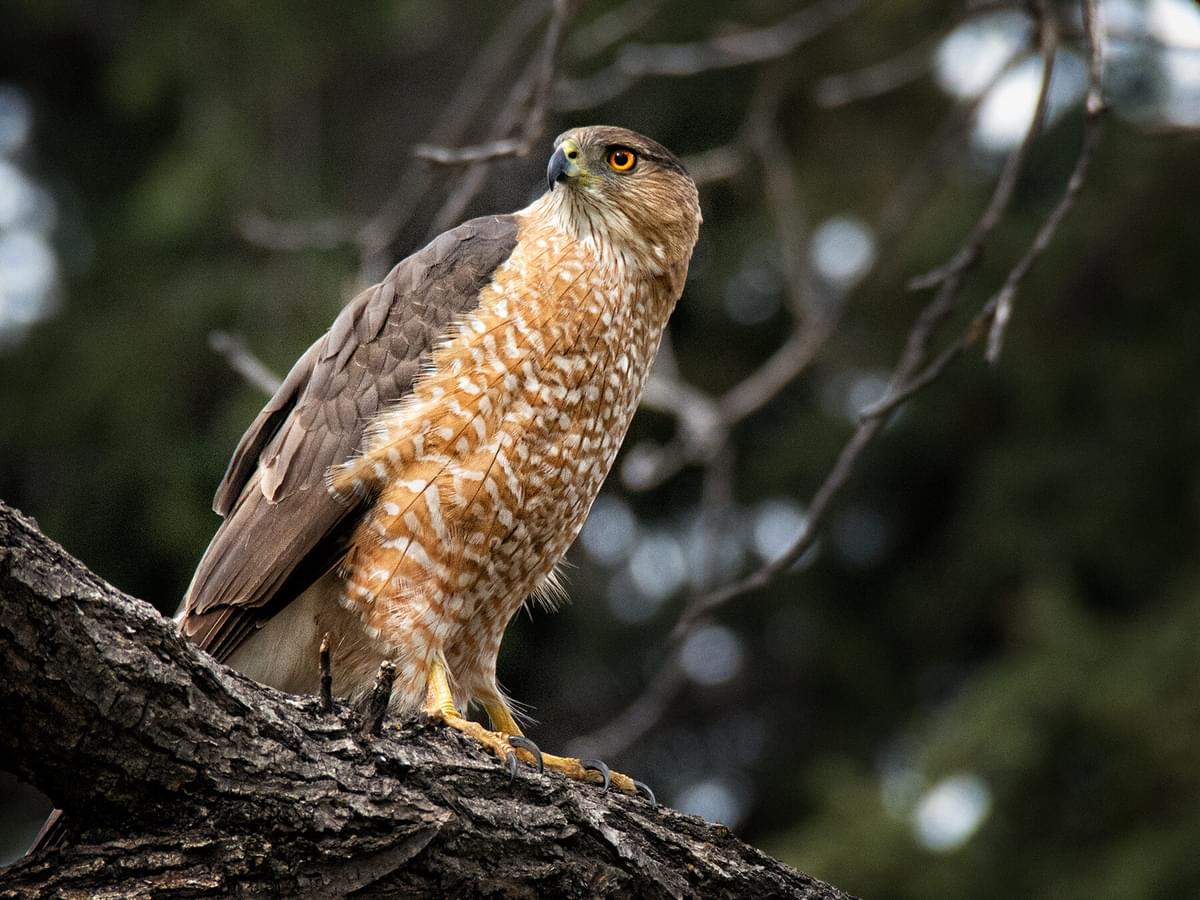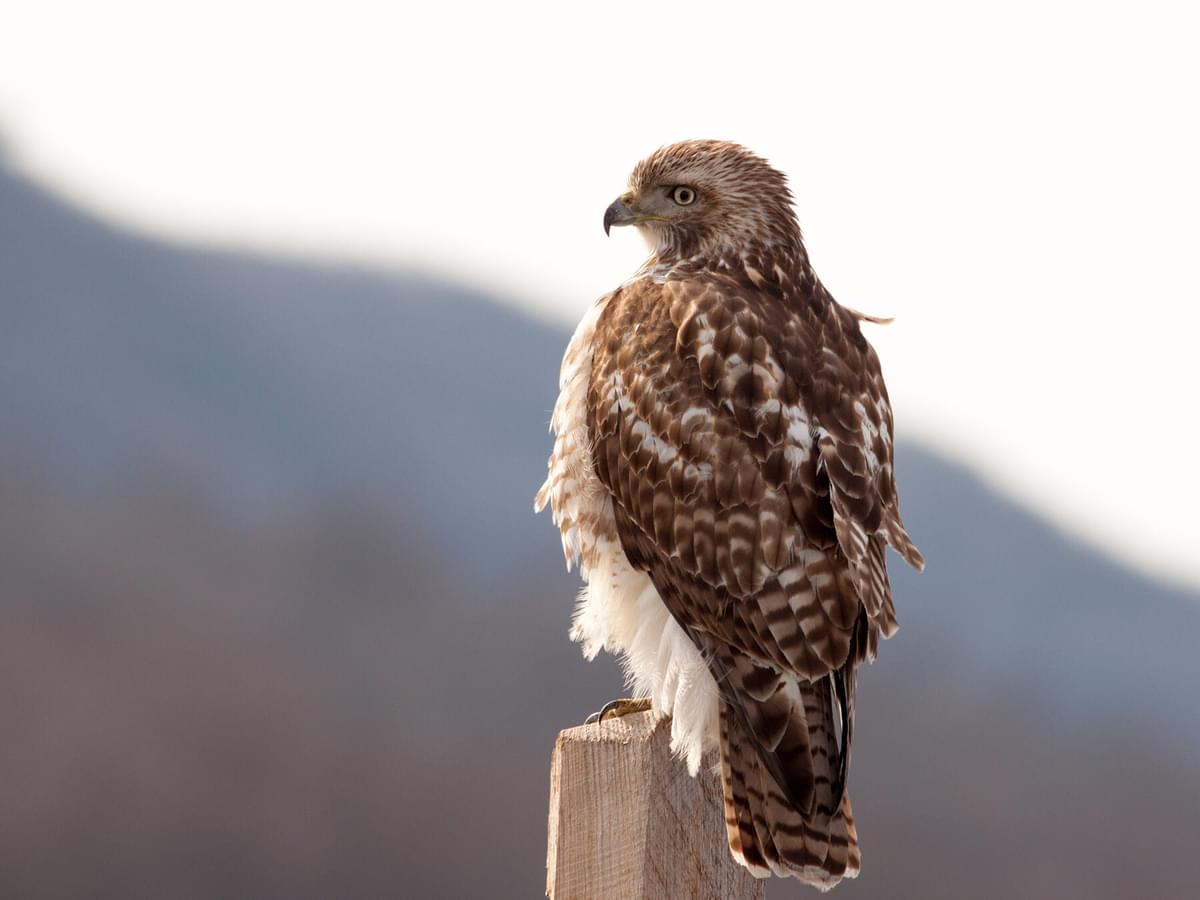Cooper’s hawk (Accipiter cooperii) and the Red-tailed hawk (Buteo jamaicensis) are both common and widespread birds of prey in North America. These birds occupy a wide range of habitats and are no strangers to backyards and suburban areas. So how do you tell the difference between these two hawks?
One of the most obvious differences between the cooper’s hawk and the red-tailed hawk is their size. Red-tailed hawks are significantly larger and more heavily built on average, although both species are quite variable in size. The cooper's hawk also has a dark cap, distinctly grayish back with reddish underparts, and a relatively long tail. This contrasts with the overall brown upper parts of the red-tailed hawk, which also has a characteristic reddish tail when viewed from the back.
There are some other physical differences to look out for too, including eye color, and tail banding. Vocalizations, hunting, feeding, and flying behaviors also differ between these two hawks, and these are covered later in this article.
Read on if you’d like to learn how to distinguish between two of America's most common raptors. We’ll also cover some interesting facts about the habits and biology of these birds along the way. So let’s get started!

Cooper's Hawk

Red-tailed Hawk
Which is bigger, a Cooper’s hawk or a Red-tailed hawk?
Size is a great way to distinguish between Cooper’s and red-tailed hawks. The red-tailed hawk is significantly larger on average than the cooper's hawk. These birds have a longer total length, wingspan, and a greater mass than the cooper’s hawk.
Here are the most useful measurements for distinguishing between these two hawks in the field:
Cooper’s hawk measurements
- Male cooper’s hawks measure about 15 inches (37-39cm) in length. Females are slightly longer at 16-17 inches (42-45cm).
- Males weigh in at 10-15 ounces (280-410g), while females tip the scales at 12-24 ounces (330-680g).
- Male cooper’s hawks have a wingspan of 24-35 inches (62-90cm), while females measure 30-35 inches (75-90cm) between wingtips.
Red-tailed hawk measurements
- Male red-tailed hawks measure 18-22 inches (45-56cm) in length, while females measure 20-26 inches (50-65cm). Male red-tailed hawks are therefore similar in length to female cooper’s hawks.
- Male red-tailed hawks have a mass of 24-46 ounces (690-1300g), while females are much heavier at 32-51 ounces (900-1460g).
- Male and female red-tailed hawks have similar wingspans of 45-52 inches (114-133cm).
Take note of the massive range of size and mass, particularly between the sexes of the two species. This is typical in raptors and very useful for making more specific identifications.

Red-tailed Hawks are significantly larger than Cooper's Hawks
Which is more common, Cooper’s hawks or Red-tailed hawks?
Both cooper’s hawks and red-tailed hawks are common and widespread American raptors. Red-tailed hawks have a much larger extent of occurrence, however, occupying a larger range of habitats and extending further to the north.
Red-tailed hawks are seen more often than Cooper’s hawks. Cooper’s hawks are a more cryptic species that spend less time soaring and don’t usually perch as prominently as the red-tailed hawk. Red-tailed hawks also call more often than cooper’s hawks, so you are more likely to notice them out in the field.
Absolute numbers are impossible to determine, but the total population of red-tailed hawks is estimated at as many as 2 million individuals, making this species far more numerous than the cooper’s hawk with an estimated population of 800 000 individuals.
Both species are listed as Least Concern by the International Union for Conservation of Nature (IUCN), and both species have increased dramatically in the last four decades.

Cooper's Hawks are generally not spotted as frequently as Red-tailed hawks
Other differences between Cooper’s hawks and red-tailed hawks
Family
Red-tailed hawks and coppers’ hawks are from different raptor genera. Although they are both known as hawks, it’s pretty helpful to separate them further into buteos and accipiters respectively. This distinction is helpful here and will also come in handy when identifying other American hawks in the field.
Red-tailed hawks are from the Buteo genus. These are medium to large hawks that mostly hunt by catching their prey on the ground. They have broad wings with prominent primary feathers when seen in flight. Other well-known buteo hawks include red-shouldered, ferruginous, and Harris’s hawks.
Cooper's hawks are from the Accipiter genus. These are mostly small to medium-sized raptors that hunt for birds on the wing. They typically have short, rounded wings which allow them to fly at high speed between the branches and foliage in wooded environments. The sharp-shinned hawk is another example of an accipiter hawk.

Close up portrait of a Red-tailed Hawk
Flight
In open flight, cooper’s hawks have a characteristic flight pattern that consists of a few flaps, followed by a period of gliding. These birds will also soar, and then their long tails and rounded wings are conspicuous.
Red-tailed hawks spend much more time soaring at heights of up to 2,750ft (840m). You will see these hawks turning in circles or using a headwind to stay fixed in position while scanning the ground below.

Cooper's Hawk in flight

Red-tailed Hawk gliding through the sky
Habitat
Cooper’s and red-tailed hawks have different prey and hunting strategies, which is part of the reason why these birds are usually found in different habitats. Red-tailed hawks are mostly found in more open areas, whereas cooper’s hawks are birds of woodland and forest habitats.
Diet and hunting
Red-tailed hawks feed on a variety of different birds and animals that they catch on the ground. The most frequently recorded prey items include rodents and rabbits, small game birds, and reptiles. Their hunting technique involves perching in an elevated position like a utility pole or soaring above and looking for prey items below.
Cooper's hawks hunt mostly for songbirds that they catch in flight. They generally hunt in wooded areas, where they use their incredible agility and speed to chase down their prey while dodging tree trunks and branches. Cooper's hawks usually target medium-sized birds like mourning doves, robins, and European starlings, although they will also feed on small mammals like chipmunks.

A male Cooper's Hawk on the lookout for prey
Life expectancy
Wild red-tailed hawks are known to live as long as 25 years, and one captive specimen was recorded to live over 29 years. Cooper’s hawks have not been found to live as long, with a record age of 20 years.
Calls
The typical red-tailed hawk call is a two to three-second long high-pitched call. It can be described phonetically as ‘keeearrr’, or ‘kee-eee-arr’. This call is most often made while the birds are in flight, and may sound like a single drawn-out note or have a shaky quality.
Cooper’s hawks have a more varied repertoire of calls, although they tend to call less often than red-tailed hawks. The most commonly reported calls include a ‘cak-cak-cak’ alarm call, a short ‘kik’ note mostly produced by males, and a longer ‘whaa’ call mostly produced by females.

Red-tailed Hawk flying low over the grass
Coopers hawk plumage
Adult coopers hawks are quite distinct from red-tailed hawks when it comes to plumage coloration and patterning. These are the most important features to look out for:
- Cooper’s hawks have a uniform blue-grey back and upper wings.
- Cooper’s hawks have a dark cap on the top of their head.
- The underparts are white, becoming heavily barred in a warm red color towards the head.
- Cooper’s hawks have three bold dark bars across their tails that are visible from both below and above. The outer edge of the tail is white.
- Adult cooper’s hawks have orange to red eyes and yellow legs.

Cooper's Hawk perched in a tree
Red-tailed hawk plumage
Compare the diagnostic features of the cooper’s hawk listed above with the following features to help distinguish between the species:
- True to their name, most red-tailed hawks have reddish tails when viewed from above. This color also shows through from below when soaring birds are seen in good light.
- Red-tailed hawks occur in dark, light, and intermediate morphs. Dark morphs appear all dark when seen from below except for contrasting whitish flight feathers. Light morph individuals are mostly whitish below, with dark wingtips and trailing edges. There are prominent markings on the leading edge of the wings, and there is often a brown band across the belly.
- Adult red-tailed hawks have yellow legs and brown eyes.

Red-tailed hawk sat on a perch
Female Cooper’s hawk vs Female Red-tailed hawk
The females of both cooper’s and red-tailed hawks are significantly larger than the males. Apart from the size difference, the sexes are similar, so you can look for the same visual clues listed above when telling females from each species apart.
Juvenile Cooper’s hawk vs Juvenile Red-tailed hawk
Juvenile red-tailed hawks can look fairly similar to juvenile cooper’s hawks when it comes to coloration. The barred tail of the immature red-tailed hawk, and the fact that both species have yellow eyes and legs, are likely to cause some confusion here. Look for the following features to help distinguish between juvenile red-tailed and juvenile cooper’s hawks.
Apart from size, tail length, behavior and other clues, the bars on the tail are the best way to distinguish between immature cooper’s hawks and red-tailed hawks. Juvenile Cooper’s hawks have the characteristic long tail of accipiters, with three dark bands and a white edge. Juvenile red-tailed hawks have six or more fine horizontal bands.
